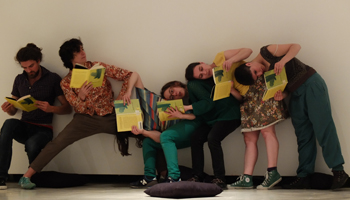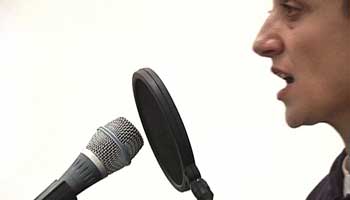2014-2015
12€
20:30h
This action will take place from 18h to 20:30h at the Hall of El Mercat and It will be free

In this workshop I intend to share an exercise with the participants that reviews the “ways of dancing” that I have practiced so far. I’m the kind of choreographer who always wants to keep on dancing. I’m also the kind of choreographer who, as they want to keep on dancing, is always wondering how to keep on dancing. In my research into the question I have managed to dissect aspects such as pleasure, exhibition, skill, feat; others, such as writing, history and memory; and others such as the group, choir and choreography. Reading while dancing and/or dancing while reading is one of the exercises that has recently helped me to tackle some of the difficulties I’m faced by when it comes to carrying on dancing. This reversibility or bi-directionality in the verbs, reading-dancing/dancing-reading, has solved some difficulties and at the same time enabled me to practice some of the above mentioned aspects. Therefore, the exercise proposed for this workshop includes: skill (reading while dancing), pleasure (dancing while reading), achievement (a text, a novel, complete from beginning to end), writing (text in movement), history (the reading of a body), memory (one body reading), choreography (writing), choir (a group doing the exercise), a group (something impossible, an attempt in unison).
Reading and Dancing
The results of this workshop will be submitted as a proposal in the context of the 5th Irregular Section during two evenings in a programme shared with Itziar Okariz and Myriam van Imschoot. If you wish to participate, please send an email to seccioirregular@mercatflors.cat explaining your motivations.
Idea Idoia Zabaleta
Performers 9 dancers/ readers participating in the workshop “Reading and Dancing” Patricia Carles, Marián de la Chica, Maria García Vera, Magdalena Garzon, Angela Koldo, Xavi Manubens, Guillem Mont de Palol, Angela Peris, Gisela Riba, Idoia Zabaleta.
Idoia Zabaleta. Choreographer. She holds a degree in biology and is a specialist in ecosystems and population dynamics. She studied improvisation and new dance in Barcelona, Florence, Amsterdam and New York. She worked with the Mal Pelo company from 1995 to 1999. Since 2000 she has co-produced and choreographed her own work, collaborating with other artists and researchers such as Isabel de Naverán, Filipa Francisco, Antonio Tagliarini, Ixiar Rozas and Jaime Conde Salazar among others. Her work has been presented at international festivals and meetings. She teaches on various postgraduate and masters courses. Since 2008, together with Juan González, she has promoted and directed AZALA, a space for artistic creation and residencies located in the same village where she lives.

Polyphony is the style that simultaneously combines a series of voices, each of which forms a melody, singing in harmony. In this program we propose polyphony as a window through which to contemplate the plural and defined yet interwoven forces acting on the work of the voice. The program is part of a research project by Myriam van Imschoot. Following her work with monochromes, monodies and solos, she is now exploring the vocal techniques, traditions and practices linked to the polyphonic rationale.
For the Carte Blanche Van Imschoot comes together with Victoria Hanna, the great vocalist and singer from Jerusalem. For their first collaboration they explore a range of vocal expression – from stutter to cry (based on the Zaghareed) – as a way to tickle the multiple sonic resonances in the space and the imaginaries of the public.
Myriam van Imschoot (1969) is an artist who lives in Brussels. She occupies an idiosyncratic position on the arts scene at large. Research is crucial to her work, which results in clusters and cycles of pieces. She gives performances, creates sound poetry and vocal pieces, and presents audio and video installations. In her first pieces she worked with cassettes, tapes, minidiscs from a personal archive, which led to her interest in oral transmission, vocal practices and memory. In her yodeling pieces, Hola Hu (2013) and Kucku (2014), and in YOUYOUYOU (2014), an ensemble piece based on the zaghareed, an Arab ululation, Van Imschoot reframes vocal practices and folklore with unexpected glitch. In What Nature Says, which recently premièred in Kaaitheater, five performers imitate their “natural environment” using only the voice. In the frame of We Love Radio the piece was broadcasted live to an audience at Mercat de les Flors as well as other listeners across the world. During the 2015-2016 season she will carry out a research project on polyphonic performance with the support of the European project “Sharing Research, Producing Knowledge”. Her work has been presented in sound art galleries, museums, theatres and public spaces. These include the following venues: Rumpsti Pumsti (Musik), Binaural Sound Art, Sculpture International Rotterdam, Muu Galeria, Museo Reina Sofía, Kaaitheater, Campo, Kunstencentrum Buda, Vooruit, Operadagen and Frascati. Website of the artist: http://sarma.be/oralsite/pages/Digital_Portfolio/
Victoria Hanna is a vocal artist. She researches ancient sacred Hebrew texts and sets them to music that explores their mystical nature in combination with contemporary modes of communication and symbols. Her work reveals transcendental aspects of voice, text, and spatial perception, as well as an astonishing vocal range and timbre. Much of the inspiration for her current work comes from Jerusalem, where the overlapping of past and present, ancient and modern, lies at the city’s very core. Her work presents sacred Hebrew texts, prayers and spirituals in a unique and utterly modern context integrating theatre, music, spoken word and video. Victoria Hanna has performed internationally since the age of 20, and has featured in international festivals in India, Germany, Brazil, USA, Berlin, Ukraine, Mongolia, Argentina, Mexico, Czech Republic, Poland, Sweden, Japan and others. She has collaborated with international artists such as Mariana Sadovska, Eugene Hutz, Barbatuques, Bobby Mcferin, Frank London, Balkan Beat Box, Grundik and Slava.

The irrintzi is a traditional Basque shout often used on special occasions such as parties to express joy. Its origins are believed to lie in a system of communication employed over large distances in the valleys of the Basque Country. In this respect, the shout becomes a basic syntax within the limits of language.
This piece consists of shouting irrintzis using an audio device to play back the sound to the performer through a loudspeaker with a variable delay. The artist builds up a dialogue with the echoes of the irrintzi emitted by the loudspeaker, with the sounds alternating and sometimes overlapping.
Itziar Okariz is an artist whose work has often been characterized by the production of actions that challenge language norms and the production of signs that define us as subjects. Her recent individual projects include Caja Negra/Cubo Blanco: CA2M, Madrid, and Keramik Werkstatt Schaedle, Nendeln, Liechtenstein (2014); II. Irregular Section: Mercat de les Flors, Barcelona (2013); Un número de acciones determinadas: MUSAC, León (2013); Uno, uno, dos, uno: Galería Carreras Múgica, Bilbao (2012); Irrintzi, repetición: La Casa Galería, Mexico DF, (2011); Contrarywise: performance in the Picasso Museum, Barcelona, (2010); Ghost Box: Sala Rekalde, Bilbao (2008); Curating the Campus: To Pee in Public and Private Spaces: The Singel, Antwerp (2007); Talent: Vita Kuben, Umea, Sweden (2007), and Climbing Buildings: If I Can’t Dance festival, Utrecht (2007).
We have reserved seats for people who use wheelchairs. Please, contact us at publics@mercatflors.cat so we can guarantee good care